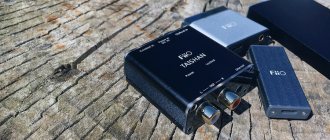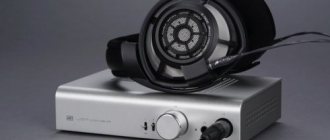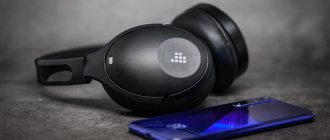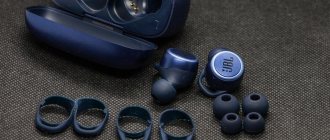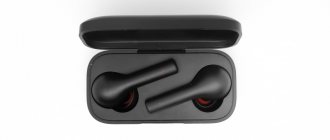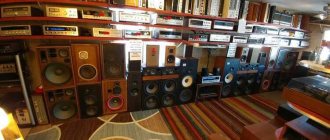A few words about Burson Audio
Burson Audio Company
founded by a group of enthusiasts in 1996 in Melbourne (Australia).
The company has an interesting backstory, since the origins of its creation were a community of audiophiles who, for several decades, gathered in the house of Mark Burson, discussing music, sound-reproducing equipment and various of their own projects. Mark himself has long been retired; his advanced age does not allow him to actively participate in the affairs of the company named after him, but his followers continue to develop the company, the products of which are slowly becoming famous outside the country of kangaroos. The origin of Burson Audio
could not but affect the philosophy of the company, which is aimed at the ideas of “pure” High End, that is, a fundamental rejection of budget solutions and mass production; the developers are exclusively interested in sound quality.
Until the mid-2000s, Australians generally released only modules for DIY fans (from the English Do It Yourself - Do It Yourself). These boards for upgrading third-party devices or DIY circuits have brought Burson Audio
considerable popularity.
For example, Australians are categorically against the use of operational amplifiers in the form of integrated circuits in analog circuits, considering them persona non grata in any audio paths of any high quality. These chips, widely used in various audio devices, especially in sources, processors and preamplifiers, reduce cost, simplify assembly, and make the final circuit more compact. But, according to Burson Audio
not everything is so rosy, since the elements integrated into the microcircuit cannot be selected with the required accuracy, and the high packing density of the elements leads to mutual interference. To replace chip operational amplifiers, Australians offer their analogues on discrete elements, called HD Audio Opamp (HDAO). They are small hand-assembled boards (single or double) on which transistors and resistors are placed, connected into a differential voltage amplifier circuit. HDAO uses Toshiba transistors that have proven themselves in the audio industry, and the resistors used are subject to rigorous selection, including a 50-hour burn-in period followed by resistance sampling with an accuracy of 1%.
Another Burson Audio solution offered on the DIY market is an improved voltage regulator for power supplies, equipped with a stabilizer and noise filter. Like the HDAO, the regulator replaces the industry standard three-pin chip and is implemented on 17 discrete elements, including Toshiba transistors, Dale resistors, Evox polypropylene capacitors, Bourns trimmers, the temperature stability of the output transistor is ensured by a fairly large heatsink. Burson Audio also has other interesting things designed to modify existing Hi-Fi equipment, for example, an ultra-low jitter board to replace the clock generator chip.
Burson Audio's developments were first translated into a finished commercial product only in 2005. Since then, the company's lineup has been regularly expanded; today, Burson Audio's product range includes a headphone amplifier, a digital-to-analog converter, an audio buffer, and several variants of these devices combined in one housing. In addition, models of integrated, pre-amplifiers and final amplifiers for “large” speaker systems are released under the Burson Audio brand. the HA-160 headphone amplifier is supplied to Russia
and the multifunctional device
HA-160D
, although a
DA-160
.
In this review we will talk about the “senior” model of the 160 series HA-160D
, which represents three devices under one cover: a headphone amplifier, a pre-amplifier and a DAC.
Burson Audio HA-160D
The device came to us in a box, the size of which is more suitable for some kind of integrated speaker amplifier, rather than headphones. The “chick” that hatched from the cardboard “egg” really turned out to be large for representatives of its species: 80x250x265 mm (HxWxD) and weighing about 7 kg. The massiveness of the device is given by the anodized aluminum body; to reduce mechanical resonances, all machine-turned panels have different thicknesses - about 6 mm, the front panel is even thicker - about 1 cm. Internal projections, monolithic with the panels, serve as natural platforms for attaching the weighty top and bottom covers, also thick not offended. In addition to mechanical stability, the cabinet has another useful property: it is an excellent heatsink for output transistors, which transfer excess heat to the bottom cover of the case.
On the facade of the Burson Audio HA-160D, a large volume knob occupies a central position, and to the left of it there are two headphone outputs. Note that these outputs are not equivalent and are intended for headphones of different impedances. On the right side of the front panel there is a small button for switching signal sources; the current selection is displayed using five LEDs with the corresponding symbols.
On the back of the device on the right there is a power input, a mains voltage switch and a switch to turn off the device. The left side of the rear panel is occupied by three analogue RCA inputs (stereo), a stereo RCA output for pre-amplifier mode and two digital inputs: USB with a B-type connector and coaxial S/PDIF. The device does not have a digital optical input.
The HA-160D comes with a small manual in English, RCA interconnect cables and a digital USB cable.
A look from the inside
Anyone looking inside the device sees a pleasant picture of a competently and neatly assembled circuit. It is clear that the creators did not save money when using elements intended for audio applications. Often in “hi-fi” devices the case is made to a standard size, but inside it is almost empty; in the HA-160D, the internal volume is quite densely occupied by various circuit components and boards, sometimes on two floors. This is explained both by the fact that the HA-160D can do a lot, and by the fact that according to the Burson Audio concept, everything that can be done on discrete elements is done on them, and this approach is not compatible with the miniaturization of the circuit.
The HA-160D power supply contains two transformers with Burson labels: one for the digital-to-analog converter circuit, the other for the output stage. Buffer capacitors of ELNA for Audio brand power supplies have a decent total capacitance of 29400 μF (2x10 thousand μF + 2x4.7 thousand μF). At the output of the blocks there are the voltage regulators already described above with stabilization and noise reduction, which end in pairs of bipolar transistors Toshiba A1930 and C5171. The final stage of the amplifier operates in pure A-class and is made using the same Toshiba transistors, and each of the two headphone outputs is served by a separate pair of transistors.
The HA-160D volume control is not made using a conventional potentiometer; the perfectionist creators preferred a different approach, making a 24-step switch using separate film resistors selected with an accuracy of <0.1%. In turn, the selector of all inputs of the device is implemented using Hongfa electromechanical relays.
The digital signal from the coaxial input is processed by the Cirrus Logic 8416-CZZ receiver, and the device's digital-to-analog converter is represented by a Burr-Brown PCM1793 chip (stereo 24 bit/192 kHz). As you can see, the converter has a fairly common filling among devices in the mid-price category; the developers did without increasing the signal bit depth, upsampling and playing with digital filters, all of which are distinguished by expensive elite DACs. However, Burson Audio engineers emphasize that they tried to take the maximum from the selected configuration, paying especially much attention to the analog wiring of the digital converter, inattention to which most often leads to degradation of the sound of DACs. To accurately amplify the low-level analog signal, proprietary solutions were used, such as modified voltage regulators on discrete elements and HD Audio Opamp operational amplifiers, assembled using Toshiba A970, K170, C2240 transistors.
The manufacturer does not provide detailed information regarding the USB digital-to-analog converter; besides, the circuit and used chips were hidden from view, and I did not want to seriously disassemble the amplifier.
We can only note that the USB receiver is protected from electromagnetic interference by an aluminum shield, and that the receiver operates in adaptive mode 24 bit/96 kHz, that is, it uses clock pulses from the signal source (computer or media player). In addition, it is known that the new external DAC Burson Audio DA-160 uses a Tenor TE7022 USB audio converter, and this DAC, according to the developers, is a tuned version of the converter from the HA-160D. We can assume that the HA-160D uses the same chip. Impressions The Burson Audio HA-160D
is a high-end, reference headphone amplifier with preamp capabilities, and an excellent DAC that rivals any other D/A converter under a thousand dollars.
During testing of the Burson Audio HA-160D
we used: CD player S.E.S. CD3300R, MUSICAL FIDELITY X-CAN v.3 amplifier, SENNHEISER HD580 headphones, NORDOST Blue Heaven analog interconnect cable, THE CHORD COMPANY Prodac Pro Digital coaxial cable, plus included cables. Let's make a reservation right away that we considered the HA-160D primarily as a headphone amplifier and part-time DAC, and were not interested in its capabilities as a pre-amplifier. You can read about which preamplifier the HA-160D makes in other reviews.
The HA-160D needs a noticeable warm-up. Perhaps the 100 hours recommended by the manufacturer is a reasonable amount of time, but the amplifier really needs a couple of days to get into shape. At first, the HA-160D plays rather constrainedly, but over time it simply transforms, especially in the nature of bass reproduction. Due to the A-class, the amplifier heats up noticeably, but thanks to the extensive radiator housing, it remains warm and not hot all the time, so it does not require special conditions during installation.
Many transistor circuits sound detailed, bright and dynamic, but cold and sometimes harsh. In turn, many tube amplifiers, on the contrary, sound warm and emotional, have a rich, convex palette of basic timbres, although they are noticeably inferior to “transistors” in the dynamic range, especially at the edges of the sound spectrum. Even these extreme cases have their fans, but most audiophiles are looking for a "golden mean" and, in our opinion, Burson Audio engineers have done a remarkable job to get closer to this edge. Using the analog input, after a few days of warming up, the sound of the HA-160D acquires a pleasant light warmth, emphasizing the physicality of images and the sensuality of vocal parts. The Australian gives a lot of details of timbres, painting them with texture and airiness; the endings of vocal phrases and after-sounds are well defined, while dryness and the release of sibilants, which sometimes make listening a rather tedious task, are not at all noticeable. The trebles are clear and the trails are well-developed and transparent, although the upper octaves remain a little dark. The amplifier has excellent mid and upper bass, which are distinguished by excellent composure, the high speed of processing time transitions allows you to catch the relief of the sound of bass instruments, and even imagine the size of the soundboards and resonators. In a stereo system based on headphones, there is no need to talk about building a real music stage, but good systems can show some volume of images and their arrangement in space. In this regard, the HA-160D is a good amplifier, creating in the listener’s head a fairly stable, albeit highly compressed, semblance of a music scene with a clearly visible width and a small but tangible depth. In any case, instruments and vocalists do not tend to scatter around the headphones or sit in the center of the brain.
A common danger with all-in-one devices is that their designers have focused on creating one function and not paid as much attention to others. Having made sure that the HA-160D is a high-quality headphone amplifier, we moved on to checking the digital-to-analog converter: is it just for show?
Fortunately, no! The signal from the CD player through the coaxial input of the HA-160D was reproduced no worse than the analogue one, even better, considering that the output circuit of the CEC 3300R tends to emphasize the main timbres and slightly blur small details, especially the lower and upper octaves. Using the “coaxial” the edges of the spectrum were drawn more accurately, the boundaries of the images and the volume of the musical pseudo-scene were conveyed more accurately. Perhaps, compared to more expensive DACs, the dynamic range was slightly squeezed: the attack on loud bass and high-frequency impulses was slightly smoothed out, the micro-amplitude layers of the recordings were not shown in such detail, but the differences were quite small.
When connected to a computer via USB, the HA-160D is automatically detected as an external sound card, more precisely a Burson Audio DAC, after which sound from different applications can be sent to the device. The playback style remains unchanged, perhaps the nuances of microdynamics and articulation are smoothed out a little, but minimally. Absolutely, with headphones there is no noticeable sound degradation and the USB input of the device is as good for high-quality music as others.
Characteristics
- Type: Transistor, Headphone Amplifier, DAC
- Output power (60/300 ohms): 800/650 mW
- Frequency range: 5(-0.3dB)-35kHz (-1dB) Hz
- THD (6 mW/300 ohms): <0.001%
- S/N (at 0 dB gain): >98 dB
- Channel Crosstalk: >90/80 dB (digital/analog input, 10 kHz, 4 ohms, 1/3 power)
- Analog Inputs (impedance/sensitivity): 3xRCA (47 kOhm)
- Digital inputs: xCoax (24bit/192kHz), 1xUSB (adaptive 24bit/96kHz)
- Digital outputs: no
- Preamp Outputs (Impedance/Level): 1 (60 ohms)
- Headphone Output (Impedance): 2 (5 ohms)
- Balance adjustment: no
- Tone control: no
- Remote control: no
- Dimensions (HxWxD): 80 x 250 x 265 mm
- Weight: 7 kg
Online Audio Video Magazine AVREPORT.ru
Burson Audio HA 160
Burson Audio HA 160
- Manufacturer Burson Audio (Australia)
- Made in Australia
- www.bursonaudio.com
- RCA inputs
- Outputs 2 Phones 6.3 mm
- Input resistance, kOhm 47
- Reproducible range, Hz 5 - 35000
- With unevenness, dB -1
- Distortion, % no data
- Signal to noise ratio, dB 118
- Dimensions, mm 210 x 145 x 60
- Weight, kg 5.0
- price, rub. 26400
This modest-looking telephone amplifier is not a typical commercial product of the hi-fi industry. It was created by ordinary audiophiles and like-minded engineers, who back in 1996 were brought together into one team by the famous sound engineer and head of the Australian Society of Music Lovers Mark Berson.
There is nothing superfluous in the device. One RCA input on the rear panel and a pair of jacks for stereo phones on the front (on the right - for high-impedance, on the left - for low-impedance). The volume is not controlled by a potentiometer, but by a 24-position selector. The input part is built on high-quality low-noise operational amplifiers, the output part is built on discrete elements. The power supply is internal. All this is enclosed in a body made of polished 6-mm duralumin plates. And although the accuracy of the fit of the panels reveals the hand-made work with a file, the HA 160 is made to last. Such a case is capable of removing all generated heat without additional radiators. There are no holes in it, which means that internal elements are less susceptible to microphone effects.
1. Audez'e LCD-2
The sound does not give the impression of being very clean and harmonious, but it captivates with its expressiveness and dynamics. Resolution in the high spectrum is good, in the middle - a little worse. The bass is dense, without flabbiness, but the infra-low component is expressed modestly. In the most informative area - from midbass to metallic trebles - the reproduction is distinguished by the correct musical balance and intelligibility, although the resolution is slightly lacking on dynamic tutti. But in such cases there is no unpleasant tint or distortion - the sound remains natural and plastic. The soundstage scores well across all criteria (focus, scale, depth) and is valuable for its lack of any distracting anomalies.
2. Sennheiser HD 800
This combination captivates with its natural sound. Reproduction is much cleaner and more transparent, although not much more detailed than in the first version - the HD800’s resolution capabilities are far from being revealed to one hundred percent. The dynamics are simple, it impresses not with the energy and clarity of the attack, but with the banal volume. However, there remains a significant margin of gain. The stereo panorama is wide in the central part, but the flanking sources are squeezed - it’s as if they were pushed out to the very edges of the stage. When reproducing dynamic contrasts, one feels a smoothing and simplification of the musical pattern, although even in such cases the pair continues to delight with a comfortable, expressive and timbre-rich sound.
PLEASED
Thoughtful design, solid performance. It is universal because it is designed for phones of any resistance. It features a significant gain headroom, correct tonal balance and good resolution in the upper frequency band.
DISAPPOINTED
The energy at the lowest end of the spectrum is modest. There is some resolution deficit in the mid-frequency band as well. The sound stage can be elongated in the central part and compressed on the flanks.
headphone amplifiers | Burson Audio HA 160 | CEC HD53N | Energy Audio Head Amp M3 mod A | Graham Slee Solo SRGII | Lehmann Audio Black Cube Linear USB
share
Tags: Burson Audio

